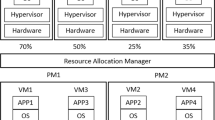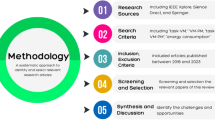Abstract
The application of edge clouds is becoming more and more widespread. The resource optimization is one of the important research contents of edge cloud. Generally, the edge cloud has limited computing resources and energy. Resource optimization can make tasks perform efficiently and reduce costs. Therefore, achieving high energy efficiency while ensuring a satisfying user experience is critical. This paper proposes the resource optimization and load balancing model. By considering factors such as user preferences, SLA and cost, the algorithm of resource optimization determines the resources scheme of edge cloud. The data movement after resource optimization is achieved through migration strategies. The load balancing of the edge cloud environment can be ensured. The results of the experiment prove that our proposed algorithm can better control costs.


















Similar content being viewed by others
References
Tong L, Li Y, Gao W (2016) A hierarchical edge cloud architecture for mobile computing. In: IEEE INFOCOM 2016—the 35th annual IEEE international conference on computer communications, San Francisco, pp 1–9
Taleb T, Dutta S, Ksentini A et al (2017) Mobile edge computing potential in making cities smarter. IEEE Commun Mag 20(3):38–43
Bilal K, Erbad A (2017) Edge computing for interactive media and video streaming. In: 2017 2nd international conference on fog and mobile edge computing (FMEC), Valencia, pp 68–73
Liguori A, Schoo P, Winandy M (2019) Mind the shift: secure migration of containerized processes in edge computing. In: 2019 6th IEEE international conference on cyber security and cloud computing (CSCloud)/2019 5th IEEE international conference on edge computing and scalable cloud (EdgeCom), Paris, pp 204–209
Xu T, Han G, Qi X et al (2020) A hybrid machine learning model for demand prediction of edge-computing based bike sharing system using internet of things. IEEE Internet Things J 516:1–12
Chuang IH, Sun RC, Tsai HJ et al (2019) A dynamic multi-resource management for edge computing. In: European conference on networks and communications, pp 379–383
Gedawy HK, Habak K, Harras K et al (2020) RAMOS: a resource-aware multi-objective system for edge computing. IEEE Trans Mobile Comput 2020:1–18
Araldo A, Stefano AD, Stefano AD (2020) Resource allocation for edge computing with multiple tenant configurations. In: ACM/SIGAPP symposium on applied computing (SAC). ACM, New York, pp 1190–1199
Tang J, Quek TQS, Tay WP (2016) Joint resource segmentation and transmission rate adaptation in cloud RAN with caching as a service. In: 2016 IEEE 17th international workshop on signal processing advances in wireless communications (SPAWC), Edinburgh, pp 1–6
Sun J, Gu Q, Zheng T et al (2019) Joint communication and computing resource allocation in vehicular edge computing. Int J Distrib Sens Netw 15(3):155014771983785
Ma S, Guo S, Wang K et al (2020) A cyclic game for service-oriented resource allocation in edge computing. IEEE Trans Serv Comput 2020:1–22
Xiong X, Zheng K, Lei L et al (2020) Resource allocation based on deep reinforcement learning in IoT edge computing. IEEE J Sel Areas Commun 38:1133–1146
Shekhar S, Gokhale A (2017) Enabling IoT applications via dynamic cloud-edge resource management: poster abstract. In: 2nd international conference. IEEE, New York, pp 331–332
Yu JJ, Zhao M, Li WT et al (2020) Joint offloading and resource allocation for time-sensitive multi-access edge computing network. In: IEEE wireless communications and networking conference. IEEE, New York, pp 1–6
Tran TX, Pompili D (2019) Joint task offloading and resource allocation for multi-server mobile-edge computing networks. IEEE Trans Veh Technol 68(1):856–868
Wang J, Zhao L, Liu J et al (2019) Smart resource allocation for mobile edge computing: a deep reinforcement learning approach. IEEE Trans Emerg Top Comput. https://doi.org/10.1109/TETC.2019.2902661
Tziritas N, Koziri M, Bachtsevani A et al (2017) Data replication and virtual machine migrations to mitigate network overhead in edge computing systems. IEEE Trans Sustain Comput 2(4):220–232
Zhao D, Yang T, Jin Y et al (2017) A service migration strategy based on multiple attribute decision in mobile edge computing. In: 2017 IEEE 17th international conference on communication technology (ICCT), Chengdu, pp 986–990
Xu X, Cao H, Geng Q et al (2020) Dynamic resource provisioning for workflow scheduling under uncertainty in edge computing environment. Concurr Comput Pract Exp 2020:1–15
Wang B, Wang C, Song Y et al (2020) A survey and taxonomy on workload scheduling and resource provisioning in hybrid clouds. Clust Comput 7:1573–7543
Plachy J, Becvar Z, Strinati EC (2016) Dynamic resource allocation exploiting mobility prediction in mobile edge computing. In: 2016 IEEE 27th annual international symposium on personal, indoor, and mobile radio communications (PIMRC), Valencia, pp 1–6
Mazidi A, Golsorkhtabaramiri M, Tabari MY (2020) Autonomic resource provisioning for multilayer cloud applications with K-nearest neighbor resource scaling and priority-based resource allocation. Softw Pract Exp 2020:1–26
Khorsand R, Ghobaei-Arani M, Ramezanpour M (2019) A self-learning fuzzy approach for proactive resource provisioning in cloud environment. Softw Pract Exp 49(11):1618–1642
Suprakash S, Balakannan SP (2019) Service level agreement based catalogue management and resource provisioning in cloud for optimal resource utilization. Mobile Netw Appl 24:1853–1861
Yu Y, Jindal V, Bastani F et al (2018) Improving the smartness of cloud management via machine learning based workload prediction. In: 2018 IEEE 42nd annual computer software and applications conference (COMPSAC), Tokyo, pp 38–44
Lee SH, Lee T, Kim S, Park S (2019) Energy consumption prediction system based on deep learning with edge computing. In: 2019 IEEE 2nd international conference on electronics technology (ICET), Chengdu, pp 473–477
Wen Y, Wang Y, Liu J et al (2020) CPU usage prediction for cloud resource provisioning based on deep belief network and particle swarm optimization. Concurr Comput Pract Exp 2020:1–16
Baek B, Lee J, Peng Y et al (2020) Three dynamic pricing schemes for resource allocation of edge computing for IoT environment. IEEE Internet Things J 7:1–13
Zhang JW, Zhu X, He WG et al (2017) The bus-bar net load forecasting based on ARIMA and PSR-BPNN. In: 2017 13th IEEE international conference on electronic measurement and instruments (ICEMI), Yangzhou, pp 247–252
Islam NN, Hannan MA, Shareef H et al (2017) An application of backtracking search algorithm in designing power system stabilizers for large multi-machine system. Neurocomputing 237:175–184
Peter D (2017) Internet traffic archive (DB/OL). http://ita.ee.lbl.gov/html/traces.html, 25 Oct 2017
de Myttenaere A, Golden B, Le Grand B, Rossi F (2016) Mean absolute percentage error for regression models. Neurocomputing 192:38–48
Hannan MA, Lipu MSH, Hussain A, Saad MH, Ayob A (2018) Neural network approach for estimating state of charge of lithium-ion battery using backtracking search algorithm. IEEE Access 6:10069–10079
Jawad M et al (2018) Genetic algorithm-based non-linear auto-regressive with exogenous inputs neural network short-term and medium-term uncertainty modelling and prediction for electrical load and wind speed. J Eng 8:721–729
Genez TAL, Bittencourt LF, Madeira ERM (2012) Workflow scheduling for SaaS/PaaS cloud providers considering two SLA levels. Netw Oper Manag Symp 104(5):906–912
Li C, Bai J, Yi C, Luo Y (2020) Resource and replica management strategy for optimizing financial cost and user experience in edge cloud computing system. Inf Sci 516:33–55
Li C, Wang C, Tang H, Luo Y (2019) Scalable and dynamic replica consistency maintenance for edge-cloud system. Fut Gener Comput Syst 101:590–604
Li C, Song M, Shaofeng D et al (2020) Adaptive priority-based cache replacement and prediction-based cache prefetching in edge computing environment. J Netw Comput Appl 165:1–21
Li C, Bai J, Tang J (2019) Joint optimization of data placement and scheduling for improving user experience in edge computing. J Parallel Distrib Comput 125:93–105
Acknowledgements
The work was supported by the Open Research Fund of National Engineering Research Center for Agro-Ecological Big Data Analysis and Application, Anhui University (No. AE201904), National Natural Science Foundation Of China (NSFC) under Grant (No. 61873341), Application Foundation Frontier Project of WuHan (No. 2018010401011290). Any opinions, findings and conclusions are those of the authors and do not necessarily reflect the views of the above agencies.
Author information
Authors and Affiliations
Corresponding author
Additional information
Publisher's Note
Springer Nature remains neutral with regard to jurisdictional claims in published maps and institutional affiliations.
Rights and permissions
About this article
Cite this article
Li, C., Tang, J. & Luo, Y. Service cost-based resource optimization and load balancing for edge and cloud environment. Knowl Inf Syst 62, 4255–4275 (2020). https://doi.org/10.1007/s10115-020-01489-6
Received:
Accepted:
Published:
Issue Date:
DOI: https://doi.org/10.1007/s10115-020-01489-6




